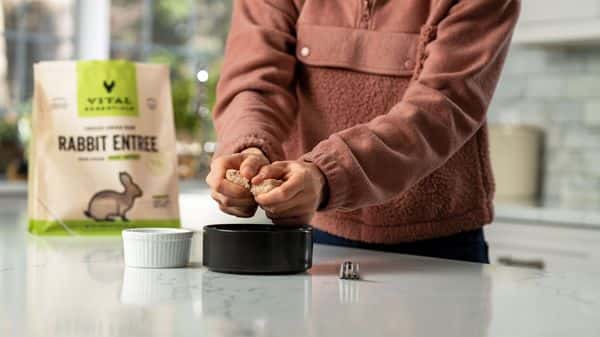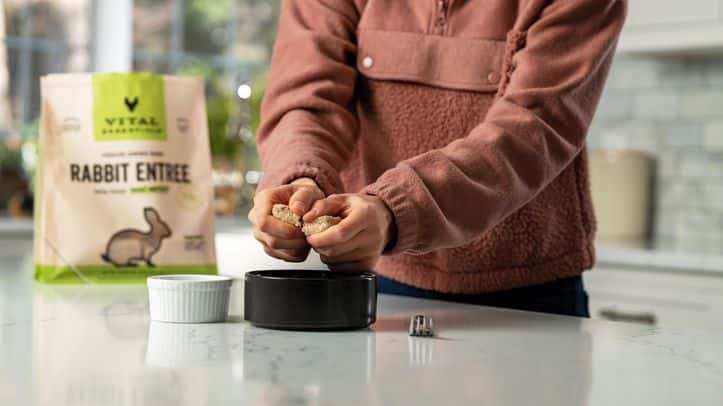
The Freeze-Dried Advantage: Freeze-Dried Pet Food Gains Popularity
10.1.2017
As more dog owners embrace the benefits of freeze-dried products, the category is taking off, affording pet specialty retailers the opportunity to strengthen customer loyalty and profits.
Pet specialty retailers who haven’t embraced freeze-dried foods and treats are missing out on significant sales potential, as more and more owners are in hot pursuit of these items. There are many reasons for the category’s growing popularity. For one, freeze-dried food and treats are highly nutritious and are excellent sources of protein. They require no refrigeration, making them easy for pet owners to store and for retailers to display. They’re also convenient to feed, mess-free and highly portable, which is especially important to dog owners who want to feed their pet a raw diet no matter where they are.
These factors, along with increased consumer awareness, improved production processes and product innovation, have sparked double-digit growth for this category, says Lori Fisher, vice president of sales for MiracleCorp Products. Located in Dayton, Ohio, the company produces a variety of pet products, including the Stewart brand of freeze-dried foods and treats for dogs and cats.
Andrea Bourne, marketing manager for Montreal-based dog and cat treat manufacturer PureBites, says category growth has been exponential and is expected to continue this trajectory over the next five years. Further fueling demand is the fact that the majority of pet owners believe their pets need a high-protein diet and that choosing the right treats will make a difference in the health of their animal companions.
According to Shelby Wisniewski, director of integrated marketing for St. Louis-based Nature’s Variety, these attitudes toward healthy pet nutrition are firmly rooted in the way today’s pet owners are feeding themselves.
“[Pet owners] are taking what they’ve learned from their own eating habits and from the natural aisles of their grocery store and they’re seeking out those same qualities in pet food,” she says. “‘Natural’ is no longer enough—consumers are paying more attention to ingredients and processing, and they’re looking for better. In their search, they’re coming to realize raw as the pinnacle of pet nutrition.”
Spreading the Word
Although freeze-dried food and treat sales have been steadily trending upward, this category nevertheless still comprises a small percent of overall food and treats sales, says Matt Koss. Koss is the founder and president of Primal Pet Foods, a Fairfield, Calif.-based manufacturer of raw frozen and freeze-dried foods and treats for dogs and cats.
Koss says this still-growing category presents pet specialty retailers with a “tremendous opportunity” to bring their customers on board. However, he cautions that customer education is critical. For example, many, but not all, freeze-dried foods require rehydration before serving (treats typically don’t).
“The moisture content of any food is one of the most critical elements to a pet’s health,” Koss says. “Therefore, retailers must make every effort to inform their customers that hydration is essential to long-term health and successful feeding when using freeze-dried foods for an everyday feeding regimen.”
Retailers must be knowledgeable about nutritional needs if they are going to direct customers to the best options for their pets, says Kevin Malnor, vice president of sales for Vital Essentials, a Green Bay, Wis.-based provider of raw frozen and freeze-dried treats, snack and entrees for dogs and cats. He adds that Vital Essentials takes pains to educate retailers and customers about species-appropriate diets.
Koss says Primal has based its business on education. “A significant amount of our resources are dedicated to training retailers on the nutritional benefits and the selling of these products,” he says. “Also, Primal is dedicated to educating consumers as to the health benefits of feeding these types of products to their pets as well as about the numerous benefits these foods offer.”
To that end, the company has committed to a free sample program that enables consumers to try the products at no cost, while giving pet specialty retailers the opportunity to talk to their customers about the features and benefits of these diets.
MiracleCorp also emphasizes education when it comes to helping consumers make “the best and most informed decisions when choosing a diet for their pets,” says Fisher. The Stewart brand supports pet specialty retailers with sales training and educational brochures, as well as online and print advertising, discount coupons and frequent-buyer cards for pet owners. Promotional deals, merchandising support, store associate discount programs and sampling opportunities are also designed to spur conversation and sales.
PureBites offers a retailer sampling program and provides free samples at dog and cat shows. The company also dedicates ample resources to merchandising tools like floor stands and clip strips, including those with seasonal and Halloween offerings.
“We’re also investing a lot in advertising with a national print campaign and social media campaign asking pet parents to turn the bag around and look at the ingredients not only for dog and cat food but for treats as well,” Bourne says. “What’s inside the bag matters, especially in helping pets live happy and healthy lives.”
Sojos provides tools to help retailers translate the details and benefits of freeze-dried items and to help customers transition from kibble and canned to raw, says Jen Loesch, general manager for the Minneapolis-based manufacturer of raw, shelf-stable foods and treats and oven-baked dog treats.
“Every day, more and more concerned pet parents are discovering the difference a raw diet can make,” says Loesch. “Numbers vary, but from what we’ve seen, the category is growing at a rate of 30 to 40 percent per year. That said, there’s still a need for education, particularly among some long-time kibble or canned users, where misperceptions of raw foods as being too hard to prepare, or too expensive, or not safe for their pets and families persist.”
Making the Sale
It’s important for pet specialty retailers to hone in on why the customer is contemplating a freeze-dried diet, says Fisher. If allergies are an issue, retailers or store associates should know what ingredients may be presenting a problem for the pet.
“Allergens can come from a variety of food, however, filler products like wheat and soy are among the top eight offenders,” Fisher explains. “And sometimes reactions aren’t from the ingredients, but from preservatives, colorings or artificial flavorings.”
Allergies can also appear from eating the same food for an extended period of time, so a rotation diet that transitions to a different variety of similar food every three months may help keep food allergies from developing, she says.
Offering a wide selection will attract interest and sales, says Koss, advising retailers to carry multiple brands. “This robust assortment allows retailers to service the needs of all pets as each brand’s product line offers varying characteristics and benefits,” he explains. “With the demand for freeze-dried products on the rise and the general demand for higher-quality pet food products, retailers have the opportunity to enhance their product offerings by stocking freeze-dried and raw-frozen foods and treats.”
As for merchandising, Koss suggests building a separate alternative food section to help them stand out from conventional kibble and canned cohorts. Along with helping to differentiate these products, a dedicated section also prompts customer inquiry, affording retailers the opportunity to engage and educate.
“This offers retailers the opportunity to better understand the pet’s nutritional needs and make appropriate suggestions as to alternative pet foods that may better serve the pet’s health,” he explains.
Be sure to put this section in a high-traffic area, advises Loesch, adding that more retailers are capitalizing on the growing demand for these products by doing just that.
Merchandising freeze-dried treats by price point across different protein options is another strategy worth considering, says Bourne, mentioning that all PureBites freeze-dried treats have a single price point. And when it comes to treats, don’t discount the importance of chatting with customers about their pet’s dietary restrictions or food sensitivities, she adds. It’s important to put them at ease by providing the information they need to make the right choices for their pets.
“A lot of pet parents skip buying treats because they are concerned or scared,” she says. “This can result in lost potential sales.”
Alternative diets are poised to become “legitimate challengers to the long-standing dominance of processed kibble and canned foods, and freeze-dried diets offer significantly higher margins compared to these,” says Loesch. “Even so, because the customer isn’t paying for water, freeze-dried foods are actually quite affordable. Most importantly, freeze-dried foods and treats offer retailers the opportunity to create long-lasting loyalty by putting their customers on the path to healthier and more vibrant pets.” PB
Check out the original article HERE!
For more information on Vital Essentials and our full product line, follow us on TikTok and Instagram. And if you have any questions, be sure to check out our FAQ page for answers. Together, we can ensure your pet gets the proper nutrition they deserve.



